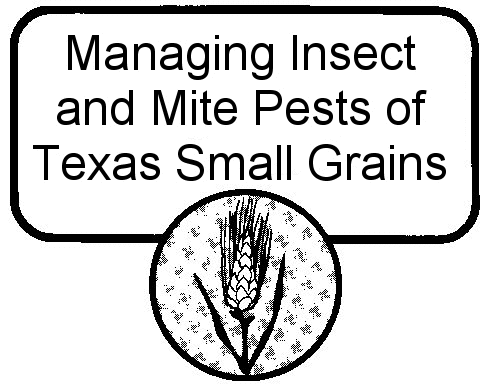

POLICY STATEMENT FOR MAKING PEST MANAGEMENT SUGGESTIONS
Seed Treatment
Planter
Box Treatment
Wireworms and False Wireworms
Red Imported Fire Ant
White Grubs
Cutworms
ABOVEGROUND PESTS OF SMALL GRAINS
Armyworms and Fall Armyworms
Greenbug
Russian Wheat Aphid
English Grain Aphid
Bird Cherry-Oat Aphid
Winter Grain Mite
Brown Wheat Mite
Wheat Curl Mite
Hessian Fly
OCCASIONAL PESTS OF SMALL GRAINS
Beet Armyworm
Chinch Bug and False Chinch Bug
Grasshoppers
Flea Beetles
Wheat Stem Maggot
INSECTICIDE APPLICATION METHODS
FEEKES SCALE OF SMALL GRAIN DEVELOPMENT
SEASONAL SMALL GRAIN PEST PROFILE
The author of this publication appreciate the assistance of entomologists of the Texas Cooperative Extension and the Texas Agricultural Experiment Station, The Texas A&M University System. For further information, contact your county Extension agent, county Extension entomologist or the Extension entomologist of The Texas A&M University System, College Station, TX 77843.
C. D. Patrick
Extension entomologist, The Texas
A&M University System.
Wheat, oats, barley and rye are important small grain crops and are often used for fall and winter grazing by livestock. The potential economic value and multiple use of these crops make pest control an important factor in efficient production.
Insect and mite pests that attack small grains may reach damaging levels throughout Texas. Producers should be aware of the probable seasonal occurrence of various pests (see Figure 9), be able to correctly identify pests and understand the various methods which are effective in preventing economic damage. Crop production planning, seedbed preparation and in-season field monitoring for detecting pest problems are important. Plant damage does not always relate directly to insect numbers. Other factors such as plant vigor and stage of growth, moisture conditions and crop rotation practices influence crop damage. Pest relationships to crops grown primarily during winter months are complicated by extremes in weather conditions. For example, pests are likely to be most severe during early fall, early spring and periods of warmer temperatures. Cold weather normally suppresses beneficial insects, which may allow pests to reach damaging levels. Pest descriptions, methods for monitoring insects and mites, and various pest control methods are included in this publication.
POLICY STATEMENT FOR MAKING PEST MANAGEMENT SUGGESTIONS
The information and suggestions included in this publication reflect the opinions of Extension entomologists based on field tests and use experience. These management suggestions are a product of research and are believed to be reliable. However, it is impossible to eliminate all risk. Conditions or circumstances which are unforeseen or unexpected may result in less than satisfactory results even when these suggestions are used. The Texas Agricultural Extension Service will not assume responsibility for risks. Such risks shall be assumed by the user of this publication.
Suggested pesticides must be registered and labeled for use by the Environmental Protection Agency and the Texas Department of Agriculture. The status of pesticide label clearances is subject to change and may have changed since this publication was printed. County Extension agents and appropriate specialists are advised of changes as they occur.
The USER is always responsible for the effects of pesticide residues on his livestock and crops, as well as for problems that could arise from drift or movement of the pesticide from his property to that of others. Always read and follow carefully the instructions on the container label.
Insect and mite infestations are often held below damaging levels by weather, inadequate food and natural enemies such as predators, parasites and pathogens. It is important to recognize the impact of these natural control factors and, where possible, to encourage their action.
Biological control is the use of living organisms (parasites, predators and pathogens) to control pests. Important natural enemies of insect and mite pests attacking wheat include several kinds of parasitic wasps, lacewing flies and lady beetles.
Biological control is most effective when used with other compatible pest control practices in an integrated pest management (IPM) program. These practices include cultural control, host plant resistance and the selective use of insecticides when other practices fail to keep pest numbers below acceptable or economic levels.
Biological control agents present little or no risk to human health or the environment. Also, few pests are known to have become resistant to natural enemies as commonly occurs with insecticides. The Texas A&M University System is committed to the development of pest management tactics which use biological control.
Methods of biological control are conservation, importation and augmentation of natural enemies. Existing populations of natural enemies are conserved by avoiding the use of insecticides until they are needed to prevent the development of economically damaging pest infestations. Insecticide impact also can be minimized by using insecticides that are more toxic to the target pest than to the natural enemy. Certain cultural practices also can encourage natural enemies.
Importation is the identification, collection and release of natural enemies into areas where they do not occur naturally. This method has been effective where an exotic pest has entered Texas without the natural enemies that help control the pest in its native country. Several species of natural enemies have been imported into Texas to control the Russian wheat aphid.
Augmentation is the purchase and periodic release of natural enemies that do not naturally occur in sufficient numbers to provide pest control. Green lacewing flies and convergent lady beetles are sometimes sold for release in wheat. Because definitive information on augmentation (when to apply, how many to release, etc.) is lacking, entomologists with the Texas Cooperative Extension cannot provide guidelines for augmentation as a management tool in wheat.
Refer to publication B-5044, "Biological Control of Insect Pests of Wheat," available from your county Extension office, for detailed information on natural enemies of insect pests of wheat and their use in biological control.
White grubs, wireworms, false wireworms and cutworms are the most common soil insect pests of Texas small grain crops. Noncrop plant materials are important food sources for soil pests. Summer fallowing and/or the use of herbicides that reduce crop residues and provide weed-free fields are important in reducing soil pests.
On-farm seed treatment can be accomplished by using a concrete mixer, custom designed seed treatment equipment or other similar seed treatment devices. Seed should be evenly coated with insecticide. Sprinkle 1 pint of water on each 100 pounds of seed and mix to coat the seed evenly with moisture. Add the correct amount of insecticide to the seed as specified by the insecticide label and mix thoroughly.
Insecticides applied to seed to prevent damage while seed is in storage will not control soil pests.
Lindane is specifically formulated to be used as a planter box seed treatment for control of seed feeding wireworms and fire ants. This soil insect control technique should be used in strict accordance with current label instructions.
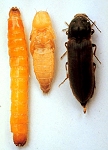
|
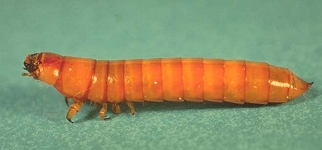
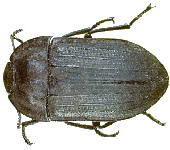
|
Wireworms and false wireworms damage small grains by destroying planted seed and by feeding on seedling roots. Stand establishment and plant vigor may be reduced. Fields should be sampled for the presence of wireworms prior to planting. False wireworms tend to occur more commonly during years of little rainfall.
Practices that reduce weeds in fields and/or rotation to warm season crops that are unfavorable for wireworm development are important cultural control methods. Rotation to crops that can be treated with a broadcast application of approved pesticides prior to planting, or seed treatment of small grains, will reduce wireworm damage.
Certain species of wireworms are abundant only in poorly drained soils. The proper drainage of such soils will help prevent damage.
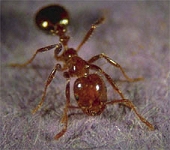
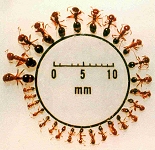 Imported fire ants feed on wheat seeds along field margins where colonies are
concentrated. Feeding may result in stand loss extending 10 to 15 feet into the
field. Damage is most common during dry, warm weather as germination is delayed,
allowing more time for ant feeding. Also, loose, dry soil permits ants easy
access to the seed.
Imported fire ants feed on wheat seeds along field margins where colonies are
concentrated. Feeding may result in stand loss extending 10 to 15 feet into the
field. Damage is most common during dry, warm weather as germination is delayed,
allowing more time for ant feeding. Also, loose, dry soil permits ants easy
access to the seed.
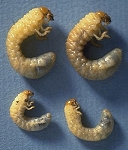
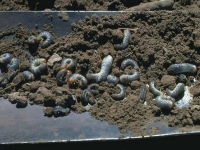 White grubs are the larval stage of May or June beetles. Larvae are
characteristically "C-shaped" with a white body and tan to brown head. The last
abdominal segment is transparent, allowing dark, digested material to be seen.
Larvae vary in size according to age and species.
White grubs are the larval stage of May or June beetles. Larvae are
characteristically "C-shaped" with a white body and tan to brown head. The last
abdominal segment is transparent, allowing dark, digested material to be seen.
Larvae vary in size according to age and species.
Damage to plants results from larvae feeding on the roots. Small seedlings are often killed, resulting in stand loss. Severely pruned roots of larger plants result in stunting and increased susceptibility to drought conditions.
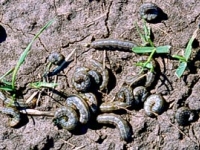 Several species of cutworms can damage small grains. Cutworms are the
immature stages of drab, brownish moths that are active at night. Grassy and
weedy fields are attractive to moths for egg laying. Newly hatched cutworms are
brown to black and feed on small grain seedlings. They clip the above ground
portion of the plant from the root system at or below the soil surface.
Cutworm-infested fields have the appearance of being closely grazed, and damage
may be "clumped" or occur in spots in the field.
Several species of cutworms can damage small grains. Cutworms are the
immature stages of drab, brownish moths that are active at night. Grassy and
weedy fields are attractive to moths for egg laying. Newly hatched cutworms are
brown to black and feed on small grain seedlings. They clip the above ground
portion of the plant from the root system at or below the soil surface.
Cutworm-infested fields have the appearance of being closely grazed, and damage
may be "clumped" or occur in spots in the field.
Aerial or ground applications of approved pesticides are effective in controlling cutworms in established small grain stands.
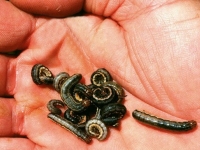
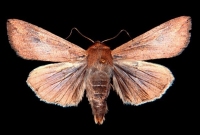
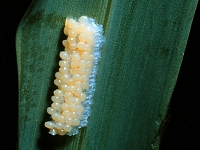 Armyworms are the immature stages of dull-colored, nocturnal moths. Several
species of armyworms damage small grains. Armyworms range in color from pale
green to brown or black and often are striped with white to yellowish lines from
head to tail.
Armyworms are the immature stages of dull-colored, nocturnal moths. Several
species of armyworms damage small grains. Armyworms range in color from pale
green to brown or black and often are striped with white to yellowish lines from
head to tail.
Armyworm outbreaks are favored by cool, damp weather. Caterpillars are attracted to green, lush-growing small grains. True to their common name, army-worms may attack small grain fields in large numbers, devouring all plant material in their path. In taller, more mature plants, armyworms may feed on leaves within the crop canopy, causing extensive damage before being detected. Periodic inspection of small grain fields is strongly advised. Early armyworm detection is also important because small larvae are more easily controlled with insecticides, but small armyworms are often difficult to find. When inspecting, search the ground for these small green worms. Control measures are recommended when four to five larvae per square foot are found in combination with seedling stand loss or with foliage loss on older plants.
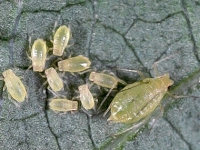
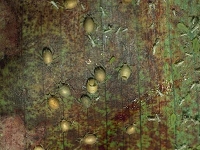
Sampling for Greenbugs. While walking diagonally across the field, make a minimum of five random counts per 20 acres of field area, each consisting of one linear foot of row. Greenbugs can be counted on small plants. On larger plants, slap the plants against the ground to jar greenbugs loose for counting. If greenbugs are numerous, estimate the number present. Make counts during the warmest part of the day when greenbugs are most likely to be exposed on the above ground parts of the plants. During periods of cool, dry weather, greenbugs may congregate in loose soil at the bases of plants, making detection and chemical control difficult.
When to Treat. The need to apply insecticide depends on the number of greenbugs present, the size and vigor of plants, the temperature, time of year, moisture conditions, stage of plant growth and effectiveness of parasites and predators. Irrigated small grains can withstand larger greenbug populations than dryland small grains.
Greenbug populations may be reduced by predators and parasites, including lady beetles, parasitic wasps, spiders, damsel bugs, lacewing larvae and syrphid fly larvae. However, cool conditions greatly limit the activity of these beneficial insects. The convergent lady beetle and the parasitic wasp Lysiphlebus testaceipes are the most important beneficials. They are able to reproduce during warmer periods of the growing season, and under conditions favorable for their development they can suppress greenbug infestations.
It is impractical to outline specifically all conditions under which insecticides should be applied for greenbug control. However, the following information may serve as a general guide in determining the need for treatment.
| Plant height (inches) |
Number of greenbugs per linear foot |
|---|---|
| 3-6 | 100-300 |
| 4-8 | 200-400 |
| 6-16 | 300-800 |
The appearance of dead plants caused by greenbug feeding in spots within the field also may indicate a need for treatment. Occasionally, populations of 25 to 50 greenbugs per foot of drill row in very young, small grain plants may warrant treatment.
Heavy, rapidly increasing greenbug infestations can cause excessive damage; however, lady beetles and parasitic wasps, under favorable weather conditions, can reduce greenbug populations to below the treatment levels given above. Where there are one to two lady beetles (adults and larvae) per foot of row or 15 to 20 percent of the greenbugs have been parasitized, control measures should be delayed until it can be determined if the greenbug population is continuing to increase. When weather conditions remain favorable for a high level of activity by these beneficials, they will significantly reduce the greenbug populations during the following week.
Insecticide Resistant Greenbugs. Greenbug resistance to registered insecticides has created problems for small grain producers in the Texas High Plains. An extensive 1992 survey in Texas High Plains sorghum found insecticide resistant greenbugs in 14 counties, especially north of Amarillo. Insecticide resistant greenbugs are known to overwinter in small grains. Insecticide resistant greenbugs are also known to develop following an insecticide treatment for Russian wheat aphids. Every effort should be made to limit insecticide applications to fields where economic thresholds have been exceeded. Producers have no choice but to begin to settle for a lower degree of control. In most situations, the most one can now accomplish is to lower the infestation pressure until weather or other natural factors intervene.
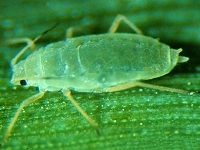
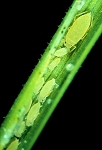 The first appearance of the Russian wheat aphid in the U.S. was in March 1986
in the Texas High Plains. It has since extended its range throughout the Great
Plains, into Canada and west to the coast.
The first appearance of the Russian wheat aphid in the U.S. was in March 1986
in the Texas High Plains. It has since extended its range throughout the Great
Plains, into Canada and west to the coast.
The Russian wheat aphid is approximately 1/16 inch long, lime green in color and spindle-shaped. It has short antennae and no prominent cornicles, but a projection above the cauda (tail) gives it a "double tail" appearance.
Russian wheat aphids inject a toxin while feeding, causing white and purple longitudinal streaks on leaves. Heavily infested plants will appear flattened and leaf edges will roll inward, giving the entire leaf a tube-like appearance. Russian wheat aphids prefer feeding on the younger, uppermost leaves of a plant. They may be vectors of viral diseases.
Russian wheat aphids exist in higher numbers and cause more damage in small grains that are stressed. Cultural practices that reduce crop stress should be emphasized. Destroying volunteer wheat and planting later are important cultural practices that delay initial aphid infestation.
Recent research has shown that predators and parasites play an important role in suppressing the Russian wheat aphid population. Many of the predators and parasites that attack the greenbug also attack the Russian wheat aphid. Wheat should be managed in such a manner as to conserve these natural enemies.
Wheat and barley are preferred Russian wheat aphid hosts, while triticale, rye and oats are less preferred. They are occasionally observed on corn and sorghum, but are not known to cause any damage. Wild hosts include cool season grasses such as jointed goat grass, various brome grasses and several species of wheat grasses. In the Texas High Plains, the aphid can oversummer on warm season grasses such as green sprangletop, buffalo grass and several species of grama grass. This aphid does not oversummer in the Rolling Plains.
Texas Agricultural Experiment Station scientists have developed economic
thresholds for Russian wheat aphids infesting wheat in late winter and spring.
The thresholds are based upon the cost of control and market value of the wheat.
For every one percent of the tillers infested, there is a 0.5 percent yield
loss.
Sampling and Economic Thresholds for Russian Wheat Aphid. While walking across a field, randomly select 100 tillers each from a different site. In order to prevent bias, select tillers without looking at them. Carefully examine each tiller and record the number infested. Consider any tiller with one or more Russian wheat aphids as infested. Determine the percent infested tillers and use the following table to decide if treatment is justified.
For example, assume the market value of the crop is projected to be $100 per acre and control costs are $6 per acre; then the treatment threshold is 12 percent infested tillers.
| Russian Wheat Aphid Economic Threshold Using Percent Infested Wheat Tillers as the Sampling Unit.* |
||||||
|---|---|---|---|---|---|---|
| Market value of crop ($) per acre | ||||||
| Control cost per acre |
50 | 100 | 150 | 200 | 250 | 300 |
| $ | --------- Percent infested tillers ---------- | |||||
| 4 | 16 | 8 | 5 | 4 | 3 | 3 |
| 5 | 20 | 10 | 7 | 5 | 4 | 3 |
| 6 | 24 | 12 | 8 | 6 | 5 | 4 |
| 7 | 28 | 14 | 9 | 7 | 6 | 5 |
| 8 | 32 | 16 | 11 | 8 | 6 | 5 |
| 9 | 36 | 18 | 12 | 9 | 7 | 6 |
| 10 | 40 | 20 | 13 | 10 | 8 | 7 |
| 11 | 44 | 22 | 15 | 11 | 9 | 7 |
| 12 | 48 | 24 | 16 | 12 | 10 | 8 |
*The data are from a single year's research and are subject to adjustment as additional information becomes available.
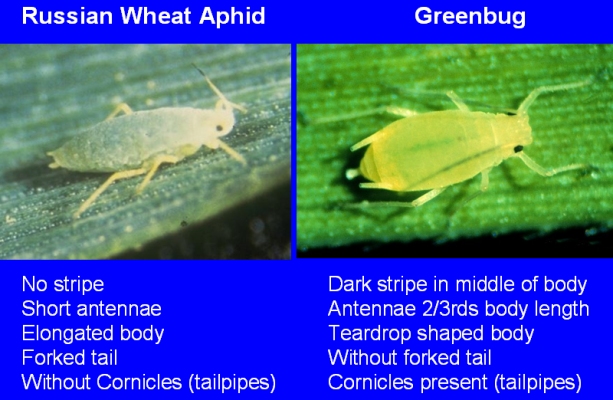 Comparison of Russian wheat aphid and greenbug. |
|---|
The winter grain mite may damage oats, wheat and barley. Mites range from 1/32- to 1/16-inch long. The adult has four pairs of reddish-orange legs, and the body is dark brown to black. Mite damage is generally more severe on grain growing on land planted in small grains in previous years. Crop rotation with crops other than small grains reduces infestations. This pest feeds primarily at night, remaining around the base of the plant during the day. The mite's activity is retarded during periods of hot, dry weather, and greatest damage occurs during winter and early spring. Mites cause leaf tips to turn brown and plants to become stunted with a silvery-gray appearance. These symptoms and the presence of mites indicate the need for control. |
Wheat Curl Mite
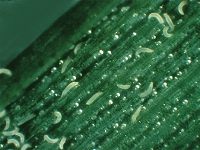 The wheat curl mite is approximately 1/100-inch long, white, sausage-shaped,
and has four small legs on the front. It carries and spreads the virus that
causes wheat streak mosaic. The mite does very little damage without the virus.
Mite feeding alone causes leaves to roll, taking on an onion-leaf appearance,
but if virus is present, yellow streaking and mottling of leaves will occur.
The wheat curl mite is approximately 1/100-inch long, white, sausage-shaped,
and has four small legs on the front. It carries and spreads the virus that
causes wheat streak mosaic. The mite does very little damage without the virus.
Mite feeding alone causes leaves to roll, taking on an onion-leaf appearance,
but if virus is present, yellow streaking and mottling of leaves will occur.
Mites reproduce most rapidly at temperatures between 75 and 80 degrees F. They crawl very slowly and depend almost entirely on wind for dispersal. The mite is most active during warm weather. It moves mostly on warm, southwesterly winds; consequently, most wheat streak mosaic virus symptoms develop from southwest to northeast across a field. Mites survive the summer on volunteer wheat and grass; volunteer wheat is the most important host for the mite as well as the disease. The potential for wheat curl mite and wheat streak mosaic virus is highest in the following conditions:
Control of wheat curl mite and wheat streak mosaic virus is achieved by managing volunteer wheat and the planting date. The usual pattern of wheat streak mosaic virus is from wheat to summer grass or crop, to volunteer wheat or early planted wheat, and then to later planted wheat. To control wheat streak mosaic virus, this cycle must be broken. During the summer, the mite can survive only a few hours without living plant tissue on which to feed. Clean tillage to destroy summer grasses, destruction of volunteer wheat, and late planting so that wheat emerges after frost are helpful practices. There are some apparent differences in susceptibility of wheat varieties to wheat streak mosaic, but none are totally resistant. Chemical control of mites has not proven to be effective.


 |
|---|


 |
The Hessian fly is a pest of small grains in 51 Texas counties. It attacks wheat, barley and rye, but prefers wheat. This pest can have two generations in the fall and two in the spring if weather is favorable. Early planted fields and volunteer plants will be attacked more severely.
Biology. Eggs are deposited on the leaf by fragile, brown, two-winged,
gnat-like females. The abdomen is a distinct orange-red color, and the Hessian
fly resembles a sorghum midge in overall appearance. A single female can deposit
from 250 to 300 eggs in clusters of 5 to 12 eggs laid end to end. Eggs hatch in
3 to 10 days. The larvae are white or greenish-white, shiny and leg-less. The
maggots work their way down the grooves of the leaf and in behind the leaf
sheath. They feed by rasping plant tissue and sucking the sap which oozes from
the irritated surface. Grain loss occurs from plant stunting, reduced grain
weight and lodging of weakened stalks. Mature larvae are 3/16-inch long and
transform into a brown puparium commonly called the "flaxseed" stage. The
Hessian fly overwinters and oversummers in this resting stage as a mature larva.
Management Strategies. Management practices farmers can use to reduce
economic losses include:
Under Texas conditions, insecticide treatments may not give economical or practical control of the Hessian fly.
OCCASIONAL PESTS OF SMALL GRAINS
False Chinch Bug
INSECTICIDE APPLICATION METHODS
Ground machines or aircraft can be used to apply most insecticides. For best results with aerial applications, flag the swaths so that they meet or slightly overlap.
Spray applications are most effective when wind velocity does not exceed 15 miles per hour. Avoid spraying when plants are wet from dew or rain. For broadcast applications, No. 3 cone nozzles set 20 inches apart on a rear-mounted boom of a tractor sprayer are satisfactory. A pump pressure of 60 pounds per square inch is recommended.
Nozzle size and number, ground speed and pressure influence the rate of output per acre; therefore, calibrate the sprayer carefully to ensure application of recommended rates.
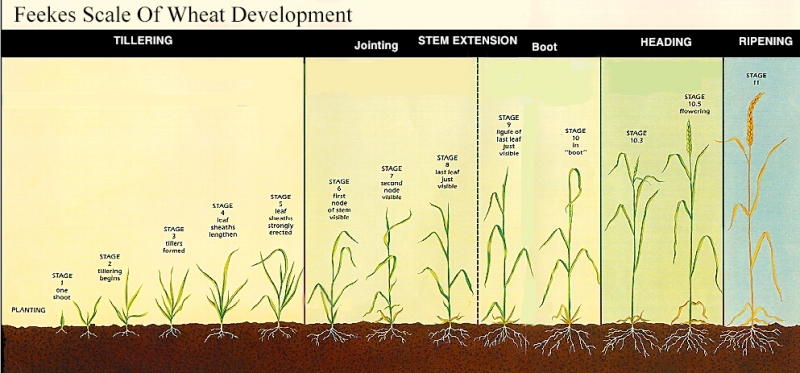 Feekes scale of small grain development. |
|---|
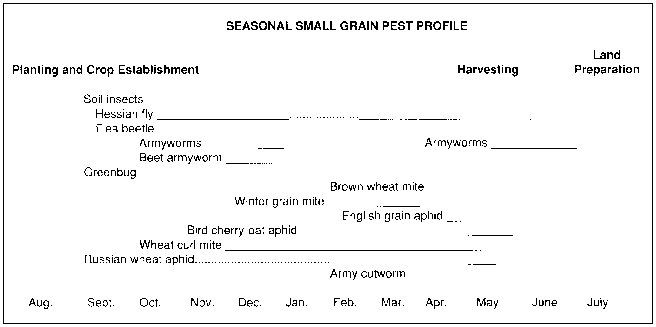 The occurrence and development of various small grain pests are usually related to plant development and various environmental factors. Although the severity of insect problems cannot be predicted, this pest occurrence profile indicates insect and mite pests that may attack small grains in various seasons and stages of development. Careful field inspection to determine the presence and damage potential of each pest is strongly advised. |
The information given herein is for educational purposes only. Reference to commercial products or trade names is made with the understanding that no discrimination is intended and no endorsement by the Cooperative Extension Service is implied. Educational programs of the Texas Cooperative Extension are open to all people without regard to race, color, sex, disability, religion, age, or national origin.
Last modified: January 2011